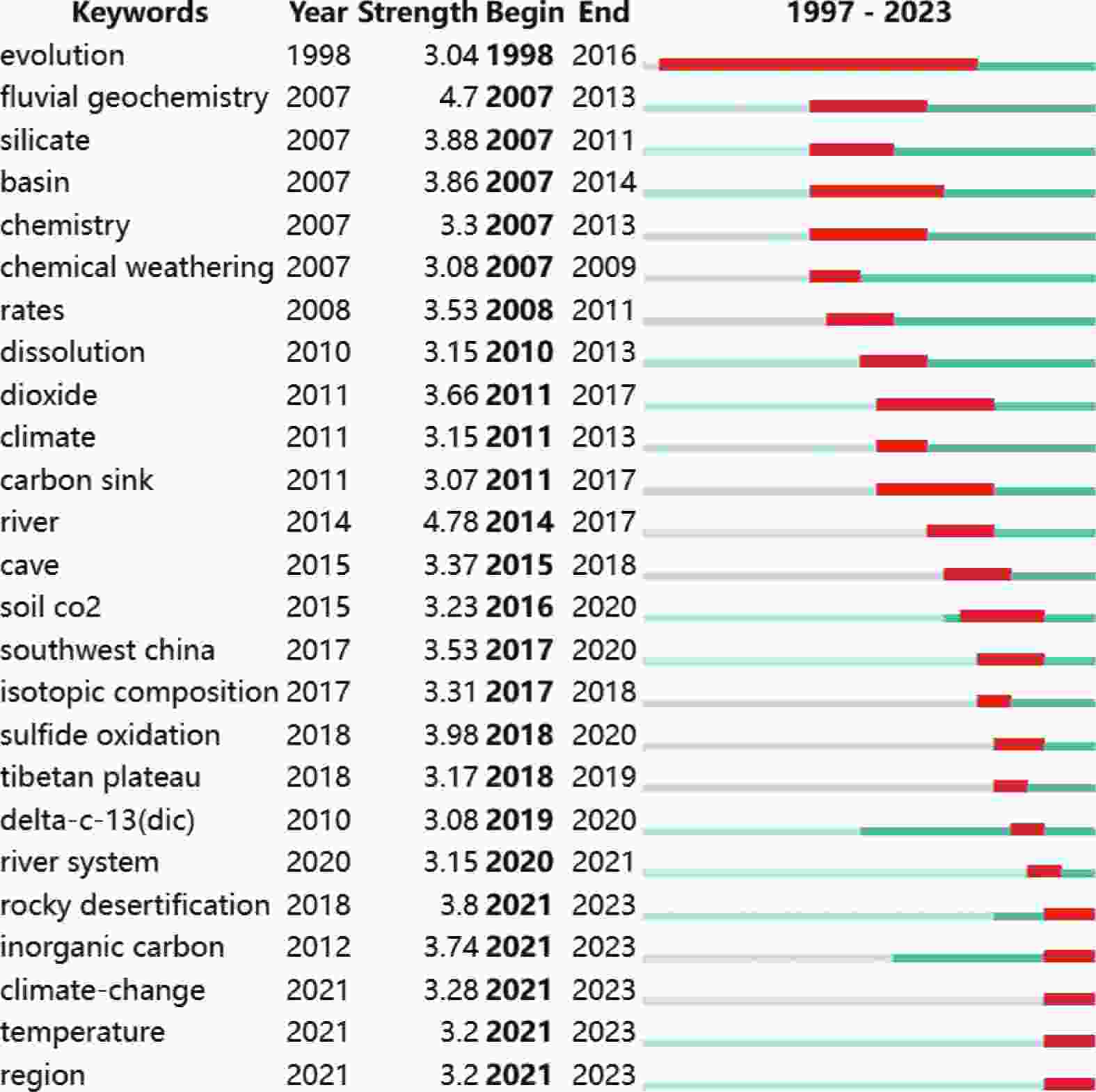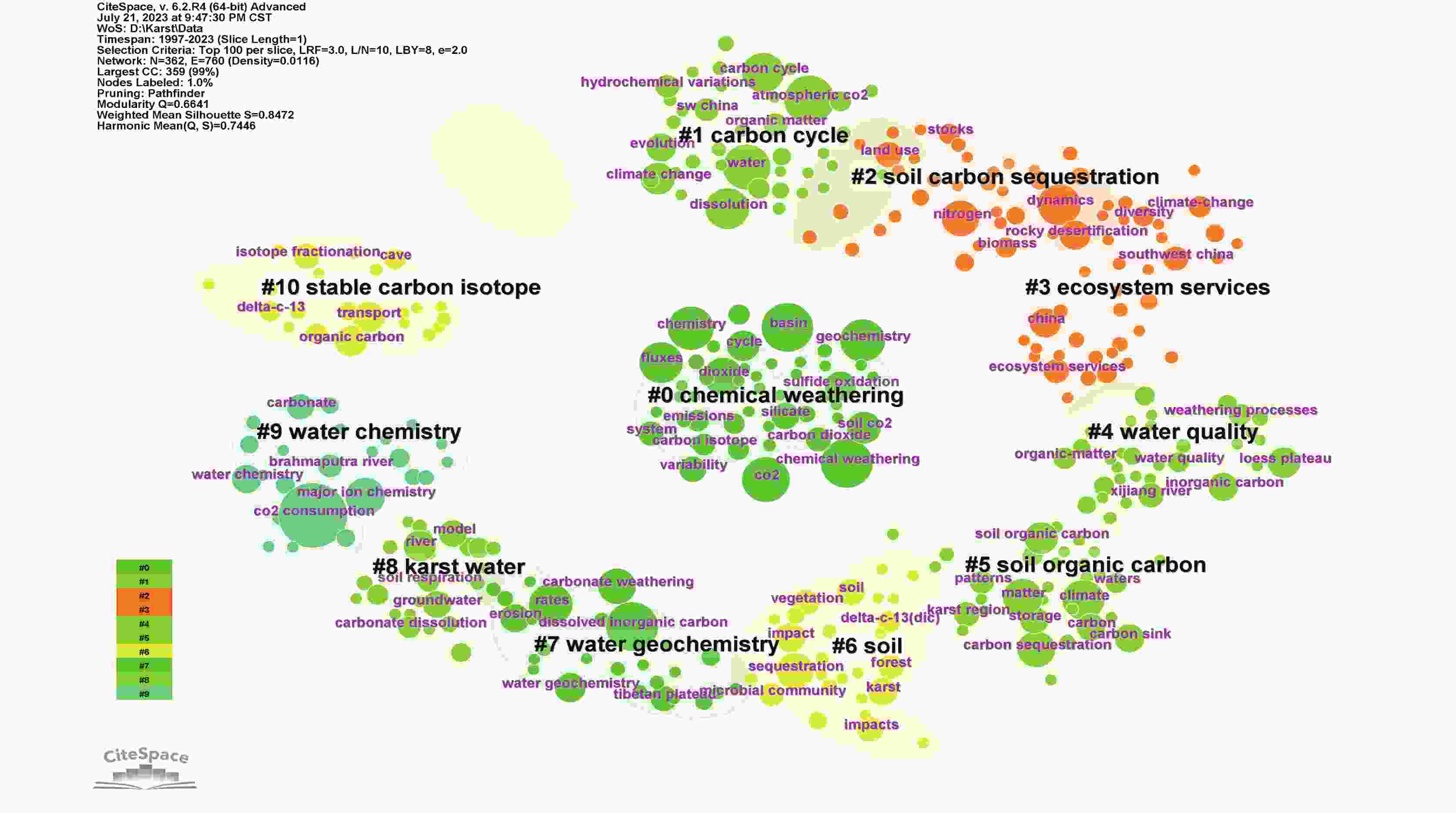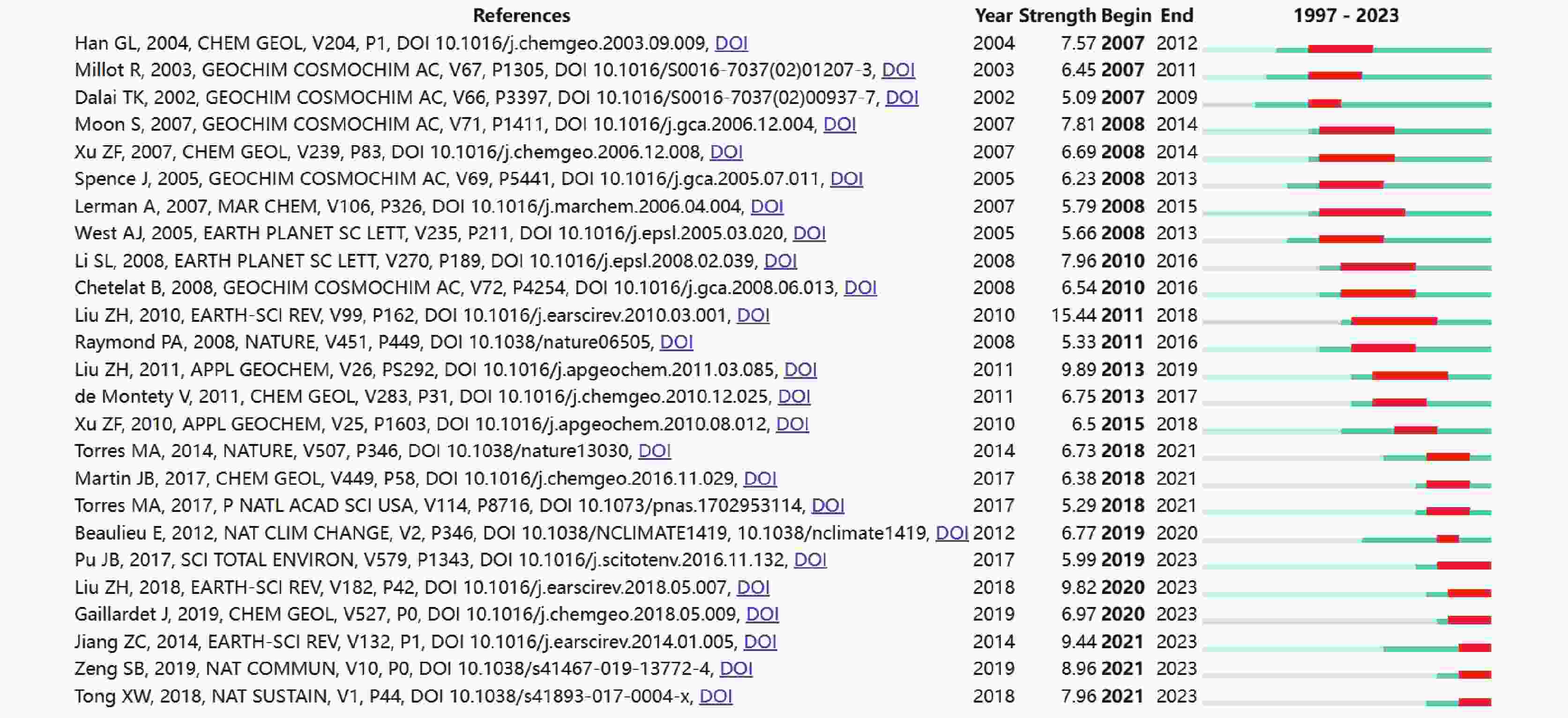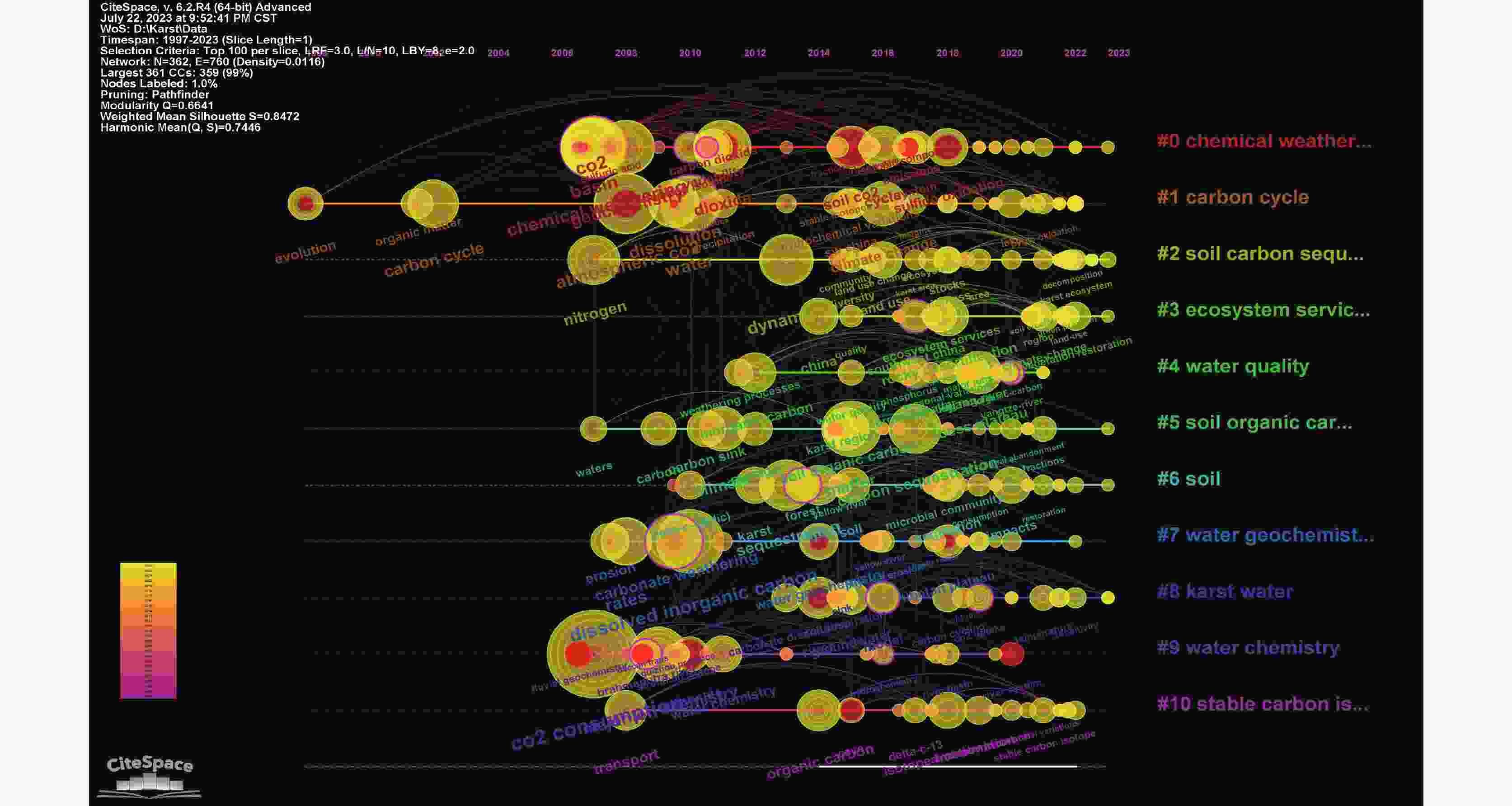| [1] |
Parrenin F, Masson Delmotte V, Koehler P, Raynaud D, Paillar D, Schwander J, Barbante C, Landais A, Wegner A, Jouzel J. Synchronous change of atmospheric CO2 and antarctic temperature during the last deglacial warming[J]. Science, 2013, 339(Suppl.1): 1060-1063. doi: 10.1126/science.1226368
|
| [2] |
Friedlingstein P, Jones M W, O'sullivan M, et al. Global carbon budget 2022[J]. Earth System Science Data, 2022, 14(11): 4811-4900.
|
| [3] |
Melnikov N B, O'neill BC. Learning about the carbon cycle from global budget data[J]. Geophysical Research Letters, 2005, 33(2): L02705.
|
| [4] |
Yuan D X. The carbon cycle in karst[J]. Z. Geomorphol., 1997, 108(Suppl.1): 91-102.
|
| [5] |
Binet S, Charlier J B, Jozja N, Defarge C, Moquet J S. Evidence of long term biogeochemical interactions in carbonate weathering: The role of planktonic microorganisms and riverine bivalves in a large fluviokarst system[J]. Science of the Total Environment, 2022, 842: 156823. doi: 10.1016/j.scitotenv.2022.156823
|
| [6] |
Liu Z H, Dreybrodt W, Wang H J. A new direction in effective accounting for the atmospheric CO2 budget: Considering the combined action of carbonate dissolution, the global water cycle and photosynthetic uptake of DIC by aquatic organisms[J]. Earth-Science Reviews, 2010, 99: 162-172. doi: 10.1016/j.earscirev.2010.03.001
|
| [7] |
Liu Z H, Dreybrodt W, Liu H. Atmospheric CO2 sink: Silicate weathering or carbonate weathering?[J]. Applied Geochemistry, 2011, 26: S292-S294. doi: 10.1016/j.apgeochem.2011.03.085
|
| [8] |
Pu J B, LI J H, Khadka M B, Martin J B, Zhang T, Yu S, Yuan D X. In-stream metabolism and atmospheric carbon sequestration in a groundwater-fed karst stream[J]. Science of the Total Environment, 2017, 579: 1343-1355. doi: 10.1016/j.scitotenv.2016.11.132
|
| [9] |
赵丽华, 吴沿友, 谢腾祥, 李海涛. 微藻无机碳利用在岩石风化及碳循环过程中的作用[J]. 中国岩溶, 2023, 42(1):1-18. doi: 10.11932/karst20230101ZHAO Lihua, WU Yanyou, XIE Tengxiang, LI Haitao. Role of carbonic utilization of microalgae on rock weathering and carbon cycle[J]. Carsologica Sinica, 2023, 42(1): 1-18. doi: 10.11932/karst20230101
|
| [10] |
Chen L F, Tan L C, Zhao M, Sinha A, Wang T L, Gao Y L. Karst carbon sink processes and effects: A review[J]. Quaternary International, 2022, 652: 63-73.
|
| [11] |
Ford D, Williams P. Karst hydrogeology and geomorphology [M]. Chichester, UK: Wiley, 2007: 1-562.
|
| [12] |
袁道先. “岩溶作用与碳循环”研究进展[J]. 地球科学进展, 1999, 14(5):425-432. doi: 10.3321/j.issn:1001-8166.1999.05.001YUAN Daoxian. Progress in the study on karst processes and carbon cycle[J]. Advance in Earth Sciences, 1999, 14(5): 425-432. doi: 10.3321/j.issn:1001-8166.1999.05.001
|
| [13] |
王世杰, 刘再华, 倪健, 闫俊华, 刘秀明. 中国南方喀斯特地区碳循环研究进展[J]. 地球与环境, 2017, 45(1):2-9.WANG Shijie, LIU Zaihua, Ni Jian, YAN Junhua, LIU Xiuming. A review of research progress and future prospective of carbon cycle in karst area of South China[J]. Earth and Environment, 2017, 45(1): 2-9.
|
| [14] |
Zhang M, Yang W, Yang M X, Yan J. Guizhou karst carbon sink and sustainability: An overview[J]. Sustainability, 2022, 14(18): 11518. doi: 10.3390/su141811518
|
| [15] |
Huang Y D, Li Q. Karst biogeochemistry in China: Past, present and future[J]. Environmental Earth Sciences, 2019, 78(15): 450. doi: 10.1007/s12665-019-8400-3
|
| [16] |
蒋忠诚, 章程, 罗为群, 肖琼, 吴泽燕. 我国岩溶地区碳汇研究进展与展望[J]. 中国岩溶, 2022, 41(3):345-355. doi: 10.11932/karst20220302JIANG Zhongcheng, ZHANG Cheng, LUO Weiqun, XIAO Qiong, WU Zeyan. Research progress and prospect of carbon sink in karst region of China[J]. Carsologica Sinica, 2022, 41(3): 345-355. doi: 10.11932/karst20220302
|
| [17] |
康卫华, 程从雨, 李为, 余龙江. 微型生物在岩溶碳循环中的作用研究回顾与展望[J]. 中国岩溶, 2022, 41(3):453-464. doi: 10.11932/karst20220312KANG Weihua, CHENG Congyu, LI Wei, YU Longjiang. Review and prospect of research on the role of mico-organisms in karst carbon cycle[J]. Carsologica Sinica, 2022, 41(3): 453-464. doi: 10.11932/karst20220312
|
| [18] |
Pan H T, Xi Z Q, Yu X T, Sun X Q, Wei X Q, Wang K. Knowledge mapping analysis of international research on acupuncture for low back pain using bibliometrics[J]. Journal of Pain Research, 2021, 14: 3733-3746. doi: 10.2147/JPR.S340992
|
| [19] |
李强. 基于文献计量学分析2016年度岩溶学研究热点[J]. 地球科学进展, 2017, 32(5):535-545. doi: 10.11867/j.issn.1001-8166.2017.05.0535LI Qiang. Research hotspots of karst in 2016 based on bibliometrics analysis[J]. Advance in Earth Science, 2017, 32(5): 535-545. doi: 10.11867/j.issn.1001-8166.2017.05.0535
|
| [20] |
钟亮, 李强. 基于CiteSpace软件分析2017年度岩溶学研究热点[J]. 桂林理工大学学报, 2018, 38(4):768-776. doi: 10.3969/j.issn.1674-9057.2018.04.020ZHONG Liang, LI Qiang. Karst research hotspots in 2017 based on CiteSpace software[J]. Journal of Guilin University of Technology, 2018, 38(4): 768-776. doi: 10.3969/j.issn.1674-9057.2018.04.020
|
| [21] |
莫春梦, 辛胜林, 肖俊波, 王俊明, 张楠. 基于CiteSpace的2010—2019年岩溶学研究热点分析[J]. 科技和产业, 2023, 23(1):152-162. doi: 10.3969/j.issn.1671-1807.2023.01.024MO Chunmeng, XIN Shenlin, XIAO Junbo, WANG Junming, ZHANG Nan. Analysis of karst research hotspots from 2010 to 2019 based on CiteSpace[J]. Science Technology and Industry, 2023, 23(1): 152-162. doi: 10.3969/j.issn.1671-1807.2023.01.024
|
| [22] |
Liu Z H, Dreybrodt W. Significance of the carbon sink produced by H2O-carbonate-CO2-aquatic phototroph interaction on land[J]. Science Bulletin, 2015, 60(2): 182-191. doi: 10.1007/s11434-014-0682-y
|
| [23] |
Liu Z H, Macpherson G L, Groves C, Martin J B, Yuan D X, Zeng S B. Large and active CO2 uptake by coupled carbonate weathering[J]. Earth-Science Reviews, 2018, 182: 42-49.
|
| [24] |
Zeng S B, Liu Z H, Kaufmann G. Sensitivity of the global carbonate weathering carbon-sink flux to climate and land-use changes[J]. Nature Communications, 2019, 10: 5749. doi: 10.1038/s41467-019-13772-4
|
| [25] |
Cao J H, Yang H, Kang Z Q. Preliminary regional estimation of carbon sink flux by carbonate rock corrosion: A case study of the Pearl River Basin[J]. Chinese Science Bulletin, 2011, 56(35): 3766-3773. doi: 10.1007/s11434-011-4377-3
|
| [26] |
Sun P A, He S Y, Yu S, Pu J B, Yuan Y Q, Zhang C. Dynamics in riverine inorganic and organic carbon based on carbonate weathering coupled with aquatic photosynthesis in a karst catchment, Southwest China[J]. Water Research, 2021, 189: 116658.
|
| [27] |
Sun P A, He S Y, Yuan Y Q, Yu S, Zhang C. Effects of aquatic phototrophs on seasonal hydrochemical, inorganic, and organic carbon variations in a typical karst basin, Southwest China[J]. Environmental Science & Pollution Research, 2019, 26: 32836-32851. doi: 10.1007/s11356-019-06374-6
|
| [28] |
Zhang T, Li J H, Pu J B, Martin J B, Khadka M B, Wu F H, Li L, Jiang F, Huang S Y, Yuan D X. River sequesters atmospheric carbon and limits the CO2 degassing in karst area, Southwest China[J]. Science of the Total Environment, 2017, 609: 92-101. doi: 10.1016/j.scitotenv.2017.07.143
|
| [29] |
LI J H , PU J B , Zhang T. Transport and transformation of dissolved inorganic carbon in a subtropical groundwater-fed reservoir, South China[J]. Water Research, 2022, 209: 117905.
|
| [30] |
Li S L, Calmels D, Han G L, Gaillardet J, Liu C Q. Sulfuric acid as an agent of carbonate weathering constrained by δ13CDIC: Examples from Southwest China[J]. Earth and Planetary Science Letters, 2008, 270: 189-199. doi: 10.1016/j.jpgl.2008.02.039
|
| [31] |
Li S L, Liu C Q, Li J, Lang Y C, Ding H, Li L B. Geochemistry of dissolved inorganic carbon and carbonate weathering in a small typical karstic catchment of Southwest China: Isotopic and chemical constraints[J]. Chemical Geology, 2010, 277: 301-309. doi: 10.1016/j.chemgeo.2010.08.013
|
| [32] |
Xu Z F, Liu C Q. Chemical weathering in the upper reaches of Xijiang river draining the Yunnan−Guizhou Plateau, Southwest China[J]. Chemical Geology, 2007, 239: 83-95. doi: 10.1016/j.chemgeo.2006.12.008
|
| [33] |
Xu Z F, Liu C Q. Water geochemistry of the Xijiang basin rivers, South China: Chemical weathering and CO2 consumption[J]. Applied Geochemistry, 2010, 25: 1603-1614. doi: 10.1016/j.apgeochem.2010.08.012
|
| [34] |
Jiang Z C, Lian Y Q, Qin X Q. Rocky desertification in Southwest China: Impacts, causes, and restoration[J]. Earth-Science Reviews, 2014, 132: 1-12. doi: 10.1016/j.earscirev.2014.01.005
|
| [35] |
Tong X W, Brandt M, Yue Y M, Horion S, Wang K L, Keersmaecker W D, Tian F, Schurgers G, Xiao X M, Luo Y Q, Chen C, Myneni R, Shi Z, Chen H S, Fensholt R. Increased vegetation growth and carbon stock in China karst via ecological engineering[J]. Nature Sustainability, 2018, 1(1): 44-50. doi: 10.1038/s41893-017-0004-x
|
| [36] |
Khadka M B, Martin J B, Jin J. Transport of dissolved carbon and CO2 degassing from a river system in a mixed silicate and carbonate catchment[J]. Journal of Hydrology, 2014, 513: 391-402. doi: 10.1016/j.jhydrol.2014.03.070
|
| [37] |
Moon S, Chamberlain C P, Hilley G E. New estimates of silicate weathering rates and their uncertainties in global rivers[J]. Geochimica et Cosmochimica Acta, 2014, 134: 257-274.
|
| [38] |
Gaillardet J, Calmels D, Romero Mujalli G, Zakharova E, Hartmann J. Global climate control on carbonate weathering intensity[J]. Chemical Geology, 2018, 527: 118762.
|
| [39] |
Martin J B. Carbonate minerals in the global carbon cycle[J]. Chemical Geology, 2017, 449: 58-72. doi: 10.1016/j.chemgeo.2016.11.029
|
| [40] |
Han G L, Liu C Q. Water geochemistry controlled by carbonate dissolution: A study of the river waters draining karst-dominated terrain, Guizhou Province, China[J]. Chemical Geology, 2004, 204(1-2): 1-21. doi: 10.1016/j.chemgeo.2003.09.009
|
| [41] |
Millot R, Gaillardet J, Dupre B, Allegrec J. Northern latitude chemical weathering rates: Clues from the Mackenzie River Basin, Canada[J]. Geochimica et Cosmochimica Acta, 2003, 67(7): 1305-1329.
|
| [42] |
Dalai T K, Krishnaswami S, Sarin M M. Major ion chemistry in the headwaters of the Yamuna river system: Chemical weathering, its temperature dependence and CO2 consumption in the Himalaya[J]. Geochimica et Cosmochimica Acta, 2002, 66(19): 3397-3416. doi: 10.1016/S0016-7037(02)00937-7
|
| [43] |
Moon S, Huh Y, Qin J H. Chemical weathering in the Hong (Red) River basin: Rates of silicate weathering and their controlling factors[J]. Geochimica et Cosmochimica Acta, 2007, 71(6): 1411-1430. doi: 10.1016/j.gca.2006.12.004
|
| [44] |
Spence J, Telmer K. The role of sulfur in chemical weathering and atmospheric CO2 fluxes: Evidence from major ions, delta C-13(DIC), and delta S-34(SO4) in rivers of the Canadian Cordillera[J]. Geochimica et Cosmochimica Acta, 2005, 69(23): 5441-5458. doi: 10.1016/j.gca.2005.07.011
|
| [45] |
Yuan D X. Sensitivity of karst process to environmental change along the PEP II transect[J]. Quaternary International, 1997, 37: 105-113. doi: 10.1016/1040-6182(96)00012-2
|
| [46] |
Liu Z H, Zhao J. Contribution of carbonate rock weathering to the atmospheric CO2 sink[J]. Environmental Geology, 2000, 39: 1053-1058. doi: 10.1007/s002549900072
|
| [47] |
Philippe Gombert. Role of karstic dissolution in global carbon cycle[J]. Global and Planetary Change, 2002, 33: 177-184. doi: 10.1016/S0921-8181(02)00069-3
|
| [48] |
Ryu S J, Lee K S, Chang W H, Shin H S. Chemical weathering of carbonates and silicates in the Han River basin, South Korea[J]. Chemical Geology, 2008, 247: 66-80. doi: 10.1016/j.chemgeo.2007.09.011
|
| [49] |
Perrin A S, Probst A, Probst J L. Impact of nitrogenous fertilizers on carbonate dissolution in small agricultural catchments: Implications for weathering CO2 uptake at regional and global scales[J]. Geochimica et Cosmochimica Acta, 2008, 72: 3105-3123. doi: 10.1016/j.gca.2008.04.011
|
| [50] |
Brunet F, Potot C, Probst A, Probst J L. Stable carbon isotope evidence for nitrogenous fertilizer impact on carbonate weathering in a small agricultural watershed[J]. Rapid Communications in Mass Spectrometry, 2011, 25: 2682-2690. doi: 10.1002/rcm.5050
|
| [51] |
Yan J H, Wang Y P, Zhou G Y, Li S G, Yu G R, Li K. Carbon uptake by karsts in the Houzhai basin, Southwest China[J]. Journal of Geophysical Research, 2011, 116(G4).
|
| [52] |
Calmels D, Gaillardet J, François L. Sensitivity of carbonate weathering to soil CO2 production by biologicalactivity along a temperate climate transect[J]. Chemical Geology, 2014, 390: 74-86. doi: 10.1016/j.chemgeo.2014.10.010
|
| [53] |
Curl R L. Carbon shifted but not sequestered[J]. Science, 2012, 335(6069): 655.
|
| [54] |
袁道先. 论岩溶环境系统[J]. 中国岩溶, 1988, 7(3):179-186.YUAN Daoxian. On the karst environmental system[J]. Carsologica Sinica, 1988, 7(3): 179-186.
|
| [55] |
袁道先. 岩溶动力系统和全球变化:为《水文地质工程地质》创刊40年而作[J]. 水文地质工程地质, 1997(4):17-18.
|
| [56] |
袁道先. 我国岩溶资源环境领域的创新问题[J]. 中国岩溶, 2015, 34(2):98-100. doi: 10.11932/karst20150201YUAN Daoxian. Scientific innovation in karst resources and environment research field of China[J]. Carsologica Sinica, 2015, 34(2): 98-100. doi: 10.11932/karst20150201
|
| [57] |
Bulthuis D A. Effects of temperature on the photosynthesis-irradiance curve of the Australian seagrass, heterozostera-tasmanica[J]. Marine Biology Letters, 1983, 4: 47-57.
|
| [58] |
Chen B, Zhao M, Yan H, Yang R, Li H C, Hammond D E. Tracing source and transformation of carbon in an epikarst spring-pond system by dual carbon isotopes (13C–14C): Evidence of dissolved CO2 uptake as a carbon sink[J]. Journal of Hydrology, 2021, 593: 125766. doi: 10.1016/j.jhydrol.2020.125766
|
| [59] |
Yan Z, Shen T M, Li W, Cheng W L, Wang X Y, Zhu M, Yu Q W, Xiao Y T, Yu L J. Contribution of microalgae to carbon sequestration in a natural karst wetland aquatic ecosyem: An in-situ mesocosm study[J]. Science of the Total Environment, 2021, 768: 144387. doi: 10.1016/j.scitotenv.2020.144387
|
| [60] |
Shen T M, Li W, Pan W Z, Lin S Y, Zhu M, Yu L J. Role of bacterial carbonic anhydrase during CO2 capture in the CO2-H2O-carbonate system[J]. Biochemical Engineering Journal, 2017, 123: 66-74. doi: 10.1016/j.bej.2017.04.003
|
| [61] |
Wang C W, Li W, Shen T M, Cheng W L, Yan Zhuang, Yu L J. Influence of soil bacteria and carbonic anhydrase on karstification intensity and regulatory factors in a typical karst area[J]. Geoderma, 2018, 313: 17-24. doi: 10.1016/j.geoderma.2017.10.016
|
| [62] |
Romero Mujalli G, Hartmann J, Borker J. Temperature and CO2 dependency of global carbonate weathering fluxes—implications for future carbonate weathering research[J]. Chemical Geology, 2019, 527: 118874. doi: 10.1016/j.chemgeo.2018.08.010
|





 下载:
下载:












